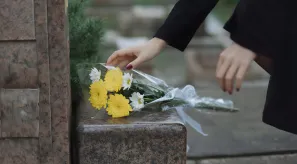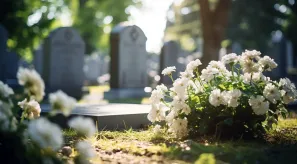When a loved one dies, it is increasingly common for family members to choose to have them cremated. This then leads to having to make an important decision: what should you do with the ashes of your loved one?
Traditional options for what to do with the ashes: urns and graves
When families have to decide what to do with the ashes of a loved one, there are an increasing number of options to choose from. The most common is to place them in an urn and transfer the ashes to a cemetery.
Once at the cemetery, the most popular choice is to place them in a columbarium inside a walled area. This is a type of vertical grave with the space for one or more cinerary urns.
Urns are the most common choice for families when it comes to where to place the ashes, although nowadays there are a wide variety of other things that can be done with them.
Modern alternatives for keeping the ashes: jewellery, art and more
In today’s world, the options available for what you can do with the ashes of your deceased loved one seem to be increasing all the time.
One option is to keep the ashes of your loved one, or part of them, at home. As mentioned, the most common option is to maintain them in an urn, but the ashes can also be kept in other ways:
- Reliquary. This is a small box or case in which the ashes of a loved one are kept. It is so called because it is a place in which to preserve relics or valuable memories. Its design and the materials used to make it can also be very varied and may include gold, silver, wood, etc.
- Jewellery. The ashes of a loved one can be kept inside a jewel (a ring, a pendant, etc).
- Diamonds. This option consists of making part of the ashes of our family member into a diamond. It is a very modern procedure which more and more families are using.
Scattering of ashes: what do you need to know?
Another popular option for the placement of the ashes is to scatter them somewhere outdoors. In such cases, you should always take into account any current legislation and environmental restrictions that may apply. It is done in open spaces such as by the sea, in the mountains or in some other place that has a special meaning for your deceased loved one.
Scattering the ashes at sea: a symbolic act of freedom
In Spain, throwing the ashes of a deceased relative into the sea is prohibited, unless it is done by a company authorised to do so. In such cases, it is the responsibility of the company to apply for the relevant permits.
The procedure should always be done with a biodegradable urn, and not by throwing the ashes out separately. The urn should be ecological or biodegradable and made from salt which will then break down when it comes into contact with water.
Preservation of ashes: how to preserve them for the future?
As we have said, urns are the most common option for families who want to keep their loved one's ashes at home or in some other significant place. But there are also options to make some of the ashes into jewellery, reliquaries or diamonds as an alternative if you want to keep a part of the ashes.
Ecological urns: an environmentally friendly option
What to do with the urn after spreading the ashes? Many families throw it away but it can also be donated or even recycled to be used again. In addition, environmentally friendly biodegradable urns that are specifically designed for burial at sea or in natural environments are becoming increasingly popular.
Frequently asked questions about what to do with the ashes of a relative
Is it legal to scatter the ashes in any location?
As is the case with at sea, any other place in a natural environment where you want to scatter the ashes of a loved one is protected by law.
Laws and regulations tell us what we are allowed to do with human ashes and how we should be going about it: asking for the necessary permits, using an approved and biodegradable container, etc.
Not following existing legislation can be considered a serious crime against the environment.
How can I decide which is the best option for my loved one's ashes?
When deciding on the best option for what to do with the ashes of your loved one, the best thing you can do is to take into account any wishes they may have expressed concerning this matter when they were still alive. However, there are other factors which may also influence the final decision such as finances, family preferences or if it is important to have a physical place to visit where your loved one can be remembered.
Can the ashes be divided among several family members?
Yes, Spanish legislation does allow the ashes of a deceased person to be divided so that several family members can receive a share so they can do as they please with them. It is essential, however, that family members all come to an agreement on this.



